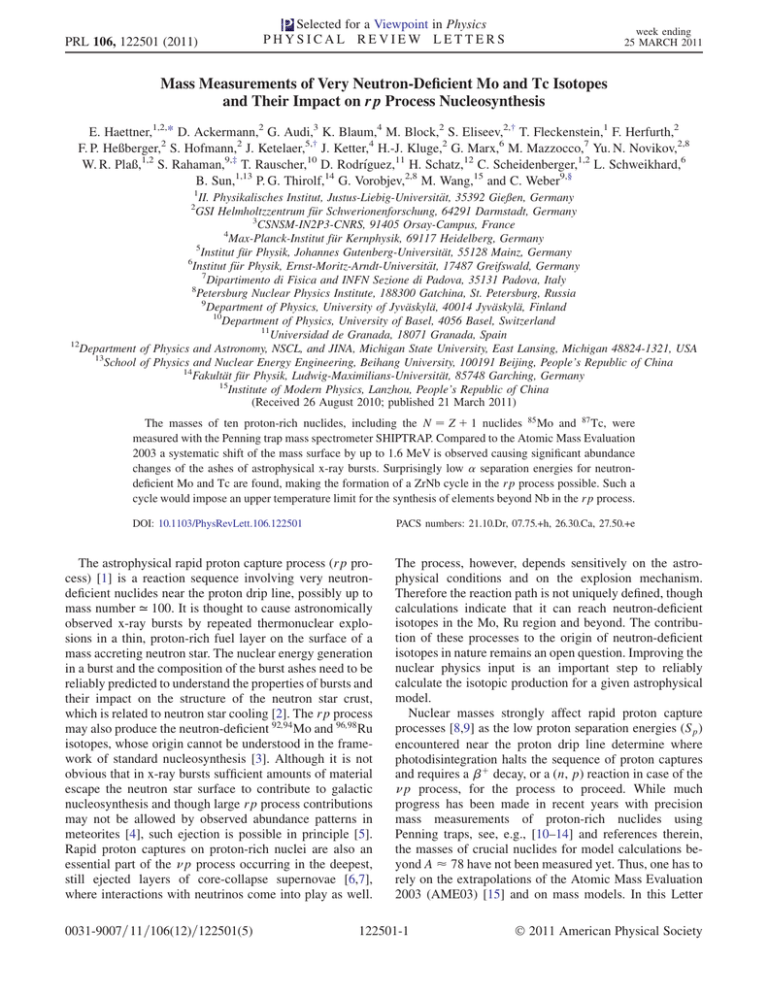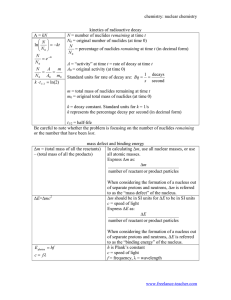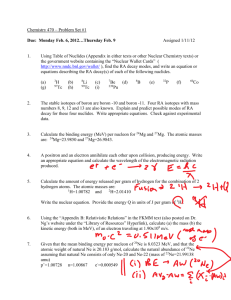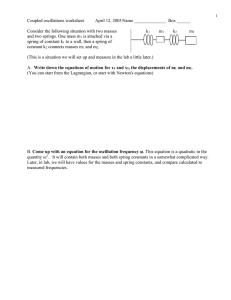Read PDF - Physics - American Physical Society
advertisement

PRL 106, 122501 (2011) Selected for a Viewpoint in Physics PHYSICAL REVIEW LETTERS week ending 25 MARCH 2011 Mass Measurements of Very Neutron-Deficient Mo and Tc Isotopes and Their Impact on rp Process Nucleosynthesis E. Haettner,1,2,* D. Ackermann,2 G. Audi,3 K. Blaum,4 M. Block,2 S. Eliseev,2,† T. Fleckenstein,1 F. Herfurth,2 F. P. Heßberger,2 S. Hofmann,2 J. Ketelaer,5,† J. Ketter,4 H.-J. Kluge,2 G. Marx,6 M. Mazzocco,7 Yu. N. Novikov,2,8 W. R. Plaß,1,2 S. Rahaman,9,‡ T. Rauscher,10 D. Rodrı́guez,11 H. Schatz,12 C. Scheidenberger,1,2 L. Schweikhard,6 B. Sun,1,13 P. G. Thirolf,14 G. Vorobjev,2,8 M. Wang,15 and C. Weber9,x 1 II. Physikalisches Institut, Justus-Liebig-Universität, 35392 Gießen, Germany GSI Helmholtzzentrum für Schwerionenforschung, 64291 Darmstadt, Germany 3 CSNSM-IN2P3-CNRS, 91405 Orsay-Campus, France 4 Max-Planck-Institut für Kernphysik, 69117 Heidelberg, Germany 5 Institut für Physik, Johannes Gutenberg-Universität, 55128 Mainz, Germany 6 Institut für Physik, Ernst-Moritz-Arndt-Universität, 17487 Greifswald, Germany 7 Dipartimento di Fisica and INFN Sezione di Padova, 35131 Padova, Italy 8 Petersburg Nuclear Physics Institute, 188300 Gatchina, St. Petersburg, Russia 9 Department of Physics, University of Jyväskylä, 40014 Jyväskylä, Finland 10 Department of Physics, University of Basel, 4056 Basel, Switzerland 11 Universidad de Granada, 18071 Granada, Spain 12 Department of Physics and Astronomy, NSCL, and JINA, Michigan State University, East Lansing, Michigan 48824-1321, USA 13 School of Physics and Nuclear Energy Engineering, Beihang University, 100191 Beijing, People’s Republic of China 14 Fakultät für Physik, Ludwig-Maximilians-Universität, 85748 Garching, Germany 15 Institute of Modern Physics, Lanzhou, People’s Republic of China (Received 26 August 2010; published 21 March 2011) 2 The masses of ten proton-rich nuclides, including the N ¼ Z þ 1 nuclides 85 Mo and 87 Tc, were measured with the Penning trap mass spectrometer SHIPTRAP. Compared to the Atomic Mass Evaluation 2003 a systematic shift of the mass surface by up to 1.6 MeV is observed causing significant abundance changes of the ashes of astrophysical x-ray bursts. Surprisingly low separation energies for neutrondeficient Mo and Tc are found, making the formation of a ZrNb cycle in the rp process possible. Such a cycle would impose an upper temperature limit for the synthesis of elements beyond Nb in the rp process. DOI: 10.1103/PhysRevLett.106.122501 PACS numbers: 21.10.Dr, 07.75.+h, 26.30.Ca, 27.50.+e The astrophysical rapid proton capture process (rp process) [1] is a reaction sequence involving very neutrondeficient nuclides near the proton drip line, possibly up to mass number ’ 100. It is thought to cause astronomically observed x-ray bursts by repeated thermonuclear explosions in a thin, proton-rich fuel layer on the surface of a mass accreting neutron star. The nuclear energy generation in a burst and the composition of the burst ashes need to be reliably predicted to understand the properties of bursts and their impact on the structure of the neutron star crust, which is related to neutron star cooling [2]. The rp process may also produce the neutron-deficient 92;94 Mo and 96;98 Ru isotopes, whose origin cannot be understood in the framework of standard nucleosynthesis [3]. Although it is not obvious that in x-ray bursts sufficient amounts of material escape the neutron star surface to contribute to galactic nucleosynthesis and though large rp process contributions may not be allowed by observed abundance patterns in meteorites [4], such ejection is possible in principle [5]. Rapid proton captures on proton-rich nuclei are also an essential part of the p process occurring in the deepest, still ejected layers of core-collapse supernovae [6,7], where interactions with neutrinos come into play as well. 0031-9007=11=106(12)=122501(5) The process, however, depends sensitively on the astrophysical conditions and on the explosion mechanism. Therefore the reaction path is not uniquely defined, though calculations indicate that it can reach neutron-deficient isotopes in the Mo, Ru region and beyond. The contribution of these processes to the origin of neutron-deficient isotopes in nature remains an open question. Improving the nuclear physics input is an important step to reliably calculate the isotopic production for a given astrophysical model. Nuclear masses strongly affect rapid proton capture processes [8,9] as the low proton separation energies (Sp ) encountered near the proton drip line determine where photodisintegration halts the sequence of proton captures and requires a þ decay, or a (n, p) reaction in case of the p process, for the process to proceed. While much progress has been made in recent years with precision mass measurements of proton-rich nuclides using Penning traps, see, e.g., [10–14] and references therein, the masses of crucial nuclides for model calculations beyond A 78 have not been measured yet. Thus, one has to rely on the extrapolations of the Atomic Mass Evaluation 2003 (AME03) [15] and on mass models. In this Letter 122501-1 Ó 2011 American Physical Society PRL 106, 122501 (2011) PHYSICAL REVIEW LETTERS direct high-precision mass measurements of nuclides on the rp process path are presented. At the velocity filter SHIP [16] superheavy elements as well as nuclides close to the proton drip line are produced in fusion-evaporation reactions. For mass measurements, the exotic nuclides are transferred to the Penning trap mass spectrometer SHIPTRAP [17]. As will be demonstrated in this work, the combination of SHIPTRAP with the high beam intensities and superb separation capabilities of SHIP provides a unique reach for highly accurate mass measurements of extremely proton-rich nuclides. The products delivered by SHIP are stopped in a helium-filled gas cell and extracted into an rf quadrupole. There, the ions are cooled and transferred in bunches to the Penning trap system. In the first Penning trap isobaric separation is carried out by mass-selective buffer-gas cooling, and in the second trap accurate mass measurements are performed using the time-of-flight ion-cyclotron-resonance technique [18]. In the present experiment fusion-evaporation products in the element range from Rb to Tc were produced with a 36 Ar primary beam of 4 1012 particles=s at energies of 5.0 and 5:9 MeV=u reacting with a 54 Fe target with an areal weight of 0:45 mg=cm2 , which has been enriched to 99%. The helium pressure in the gas cell was varied between 50 and 60 mbar. The mass measurements were performed using excitation times between 0.1 and 2.4 s. Mostly an excitation time of 1.2 s was used, which corresponds to a mass resolving power (FWHM) in excess of 106 . The masses of ten nuclides 81 Rbm , 80;81;84 Sr, 86 Zr, 85 Nb, 85;86;87 Mo, and 87 Tc were measured with accuracies ranging from 4:6 108 to 2 107 using 85 Rb as reference mass. Details of the experiment and the data analysis procedure will be the subject of a forthcoming publication. The results of the mass measurements are given in Table I. The masses of 81 Rbm and 80;81;84 Sr were measured week ending 25 MARCH 2011 and found to be in agreement with the AME03. The more exotic nuclides, however, show a significant shift of the mass surface towards less bound nuclides as compared to the AME03 and thus follow the trend observed for Nb, Tc, Ru, and Rh nuclides in previous experiments at SHIPTRAP and JYFLTRAP [11,12]. The masses of 85 Mo and 87 Tc were measured for the first time and mass excesses are found to differ from the AME03 extrapolations by 1600 and 1400 keV, respectively, well outside of the 300 keV extrapolation uncertainty given in AME03. Moreover, for 86;87 Mo, which had only been indirectly measured before [15], the shift in the mass excess values exceeds the previously given experimental uncertainties by several standard deviations. The masses of 86 Zr and 85 Nb also deviate from previous measurements listed in AME03 but agree with the values obtained at JYFLTRAP [11]. In order to investigate the influence of the new mass values on astrophysical models, a consistent mass surface is required without artificial steps in the separation energies as would occur if only individual mass values were replaced. For this reason, the new experimental mass data were added to the atomic mass evaluation together with further recent experimental work [10–13]. Taking into account the entire set of experimental masses in this region, adjusted mass values were obtained following the procedure employed in [19]. For the nuclides measured in this work these values are given in Table I column 6. Additionally, a consistent mass surface requires updated mass extrapolations due to the large mass shifts found. Thus, a new local extrapolation in the region A ¼ 80–95 was performed using the method and programs of [19]. Together with the new set of evaluated experimental data and the previously reported AME03 extrapolated mass values for A < 80 and A > 95 these data form an updated mass data set, which is labeled ‘‘AMEup’’ in this Letter. TABLE I. Measured frequency ratios (col. 2) of the nuclides investigated (col. 1) with the corresponding mass excess values based on a 85 Rb mass of 84.911 789 738(12) u [15] (col. 3), as well as the corresponding AME03 values (col. 4), differences (col. 5), AMEup, (col. 6), Sp from AMEup (col. 7) and AME03 (col. 8) and their differences (col. 9). The symbol ‘‘#’’ indicates an extrapolated value. Nuclide Frequency ratio r 81 Rbm 80 Sr 81 Sr 84 Sr 86 Zr 85 Nb 85 Mo 86 Mo 87 Mo 87 Tc 0.952 977 89(11) 0.941 264 853(50) 0.953 026 492(44) 0.988 242 201(51) 1.011 830 049(54) 1.002 008 69(52) 1.000 311 75(20) 1.012 005 301(48) 1.023 747 251(49) 1.023 863 477(53) This work Mass excess (keV) AME03 Difference 75 373:1ð8:6Þa 75 369ð6Þ 70 313:4ð3:9Þ 70 308ð7Þ 71 528:6ð3:5Þ 71 528ð6Þ 80 648:4ð4:0Þ 80 644ð3Þ 77 971:7ð4:3Þ 77 800ð30Þ 66 279:7ð4:1Þ 67 150ð220Þ 57 510ð16Þ 59 100#ð280#Þ 64 110:3ð3:8Þ 64 560ð440Þ 66 882:8ð3:9Þ 67 690ð220Þ 57 690:0ð4:2Þ 59 120#ð300#Þ 4ð10Þ 5ð8Þ 1ð7Þ 4ð5Þ 170ð30Þ 870(220) 1590(280) 450(440) 810(220) 1430(300) a AMEup 75 370:2ð4:9Þ 70 311:5ð3:5Þ 71 528:1ð3:1Þ 80 649:1ð1:3Þ 77 968:8ð3:6Þ 66 279:7ð4:1Þ 57 510ð16Þ 64 110:2ð3:7Þ 66 882:9ð3:9Þ 57 690:0ð4:2Þ Proton separation energy (keV) AMEup AME03 Difference 6797.5(6.9) 6794(9) 4(11) 6641.6(3.6) 6644(9) 2ð10Þ 8863.1(6.1) 8858(7) 5(9) 7416(19) 7250(40) 170(40) 2147.7(7.0) 2950#(300#) 800ð300Þ 3778#(300#) 4510#(410#) 730ð510Þ 5119.5(5.5) 4700(490) 420(490) 5038.6(6.9) 5160(240) 120ð240Þ 868.8(5.6) 1860#(530#) 990ð530Þ The ground and isomeric states were not resolved. It is assumed that the isomeric state was populated, since it is favored by the reaction mechanism. 122501-2 Even though the masses generally are shifted in the same direction, the AMEup table does also show changes in the separation energies compared to AME03. In particular, the Sp for 87 Tc determined in this work experimentally for the first time is 868(6) keV, about 1000 keV lower than the previous extrapolated value of 1860(530) keV. Generally, one observes lower Sp for the updated mass surface and a more linear trend (Fig. 1). To explore the impact of the new masses on the rp process in x-ray bursts, reaction network calculations using an x-ray burst model [20] were carried out. This singlezone model reproduces nucleosynthesis and energy generation reasonably well when compared to multizone burst models but its computational speed allows one to explore nuclear physics dependencies in detail. The baseline calculation uses the nuclear masses of the AME03 and calculated Coulomb mass shifts [21] for nuclides beyond N ¼ Z. The results are compared to network calculations based on the AMEup, combined with the same Coulomb mass shifts. The resulting final abundances show large differences between AME03 and AMEup in the region of A ¼ 86–96. The largest change is found for A ¼ 86 where the abundance increases by a factor of 20 (Fig. 2) due to the unexpected decrease in Sp of 87 Tc. The lower Sp of 87 Tc changes the (, p) and (p, ) rates such that the decay branch for nuclides with mass number A ¼ 86 is strengthened. This change by a factor of 20 is by far the largest observed for abundances produced in rp process network calculations since the AME 2003 evaluation. It demonstrates that nuclear physics uncertainties can be larger than estimated and can introduce large uncertainties in nucleosynthesis model calculations. Also the final abundance of A ¼ 94 increases by a factor of 2. For mass numbers between 86 and 94 the final abundances decrease. While the higher A ¼ 94 production is a step in the right direction, a much higher abundance would be required for A ¼ 94 to be coproduced sufficiently to explain the solar abundance of 94 Mo (Fig. 2). The change in A ¼ 94 production is due to the reduction of the Sp of 95 Ag (from 1040 to 790 keV), which is a result of the new mass extrapolation for 95 Ag. The results also demonstrate for the first time the existence of a pronounced island of very low separation energies (S ) for neutron-deficient Mo isotopes, starting with 85 Mo for which our measurement now provides an experimental S value (Fig. 3). A similar situation is found for the Tc isotopes with our new S value for 87 Tc. This opens up the possibility for the formation of a ZrNb cycle induced by large 84 Moð; Þ or 83 Nbðp; Þ reaction rates. The existence of such a cycle had been discussed before [22] based on the low S around 84 Mo predicted by the finite range droplet mass model (FRDM) [23]. However, the FRDM is known to underpredict S severely in other isotopic chains, and the extrapolations provided by AME03 did not show such an effect. It was therefore concluded that the existence of a ZrNb cycle is an artifact of the FRDM. Because of the new measurements this view has to be revised. The existence of a ZrNb cycle in the rp process is an important question. For a given S value of 84 Mo the cycle will form at a sufficiently high temperature, effectively providing an upper temperature limit for any rp process along the proton drip line to produce nuclei beyond A ¼ 84, including the light p nuclei in the A ¼ 92–98 mass region. In order to explore whether our new results move this temperature limit into an interesting range, calculations in the Zr-Mo region were performed using a small test 9 10 8 AME03 8 10 6 AMEup S p / M eV week ending 25 MARCH 2011 PHYSICAL REVIEW LETTERS PRL 106, 122501 (2011) x2 7 10 4 x20 6 10 2 5 87 10 Tc 0 60 -2 N=40 N=42 70 80 90 100 110 N=44 N=46 N=48 -4 77 79 81 83 85 87 89 91 93 95 97 99 FIG. 1 (color online). Proton separation energies (Sp ) of nuclides with odd Z and even N according to AME03 and AMEup. Filled symbols indicate measured values, open symbols indicate Sp where at least one of the two masses is extrapolated (#). FIG. 2 (color online). Calculated overproduction factors (produced abundance divided by solar system abundance) after an xray burst for the AME03 (dotted line) and the AMEup (solid line) mass sets. It has been assumed that all nuclei have decayed into the first stable isotope in each mass chain. The ratio of the overproduction factor for a given isotope to the highest factor found for any isotope (109 ) provides an upper limit for the contribution of x-ray bursts to the solar system abundance of that isotope. 122501-3 48 In Ag Pd Rh Ru 46 44 42 40 38 Rb Kr Br 36 Y Sr Nb Zr Tc Mo Te Sb Sn 40 20 0 1.2 36 38 40 42 44 46 48 50 52 5 4 3 2 1 0 -1 80 60 Cd Neutrons (b) 6 S / MeV 100 N=Z Stable bcycle 50 Protons (a) week ending 25 MARCH 2011 PHYSICAL REVIEW LETTERS PRL 106, 122501 (2011) 1.4 1.6 1.8 2 FIG. 4. Fraction of reaction flow branching into a ZrNb cycle for AMEupx (solid line) and AME03x (dashed line) as a function of temperature. AME03 and AMEup show no significant cycling. AME03 85Mo 82 84 86 AMEup 88 90 92 94 FIG. 3 (color online). (a) Alpha separation energies S for AMEup and the rp process path. Nuclides addressed in this work are indicated by a thicker frame. (b) S of molybdenum isotopes for the AME03 (circles) and AMEup (squares). Filled symbols indicate measured values whereas open symbols indicate S where at least one of the two masses is extrapolated (#). network with an initial 82 Zr abundance. The degree of cycling was determined as a function of temperature and density. As a measure of the degree of cycling, the fraction of nuclei bcycle that end up in the N ¼ 40 isotonic chain via 84 Moð; Þ or 83 Nbðp; Þ and do not escape the cycle via þ decay into N ¼ 43 isotones were used. In order to explore the sensitivity of the results to nuclear masses additional mass data sets AME03x and AMEupx were created. Compared to AME03 and AMEup, a few masses of AME03x and AMEupx are changed by 1 standard deviation to the most favorable conditions for a cycle (low S and low Sp for 84 Mo) to form. For each set of masses all forward and reverse reaction rates were recalculated using the statistical model code NON-SMOKERWEB version v5.8.1w [24]. Compared to AME03, calculations with AMEup, AME03x, and AMEupx increase the 83 Nbðp; Þ reaction rate by factors of 40, 3 103 , and 8 104 at 1.7 GK, respectively, while leaving the 83 Nbðp; Þ reaction rate largely unchanged. Nevertheless, even for AMEupx, the 83 Nbðp; Þ reaction rate is still 3 orders of magnitude larger than 83 Nbðp; Þ. Regardless of the masses, a cycle can therefore only form when 83 Nbðp; Þ is suppressed by a large inverse 84 Moð; pÞ reaction, or when 84 Moð; Þ becomes significant. Only for AMEupx one finds a significant bcycle for realistic temperatures up to 2 GK (Fig. 4). For higher temperatures, the radiation pressure in x-ray bursts would lead to expansion and cooling, and heavy nuclei such as 84 Mo would tend to be destroyed by photodisintegration. Both 84 Moð; Þ and 83 Nbðp; Þ play a comparable role for the degree of cycling and the result does not depend significantly on density. While for high density more material is pushed past 83 Nb, reducing the role of 83 Nbðp; Þ, 84 Moð; Þ turns out to be sufficiently fast to compensate, keeping the total bcycle largely unchanged. A density range from 105 to 5 106 g=cm3 was explored. Despite the significant cycling found for AMEupx masses at high temperatures, calculations with the full xray burst model, which reaches peak temperatures of 2 GK, show that a cycle does not occur. The reason is that at the required high temperatures the reaction sequence already stops at 56 Ni. Temperatures that allow processing beyond 56 Ni are only reached during burst cooling and are lower than required to form a ZrNb cycle. The formation is, nevertheless, a possibility in an environment where the temperature is rising slowly enough to enable the rp process to proceed past 56 Ni before reaching high temperatures. Another possibility would be an rp process with seed nuclei beyond 56 Ni. In summary, the masses of ten proton-rich nuclides were measured, among them the nuclides 84 Mo and 87 Tc. These are the heaviest N ¼ Z þ 1 nuclides measured so far, extending the previous measurements at other facilities. Thus this work marks a milestone towards high-precision mass measurements of the heavy N ¼ Z nuclides, e.g., 80 Zr and 84 Mo. The results show a shift of the mass surface towards less bound nuclei. The Sp of 87 Tc was experimentally determined and leads to large changes in the final abundance of A ¼ 86 produced in the rp process. The abundance of A ¼ 94, which is the progenitor for production of 94 Mo, was found to be sensitive to the Sp of 95 Ag. First evidence is found of the existence of an island of low S in the Mo region which is traversed by the rp process. 122501-4 PRL 106, 122501 (2011) PHYSICAL REVIEW LETTERS This results in a revised, much lower prediction of the S value of 84 Mo. This opens up the possibility for the existence of a ZrNb cycle, which would impose an upper temperature limit for the rp process to synthesize nuclei beyond A ¼ 84. In order to quantify this temperature limit and to explore to which degree such a cycle poses a limitation to current models of the rp process precise mass measurements of 80;81 Zr, 83 Nb, and 84 Mo are required. Both the low Sp of 87 Tc and the low S in the Mo region show that nuclear physics uncertainties in rp process calculations can be surprisingly large and that experiments are needed to put astrophysical models on a solid foundation. This work was supported by the Helmholtz Association and GSI (VH-NG-033), BMBF (06GI185I, 06ML236I, 06GF9103I), Max-Planck Society and Swiss NSF 200020-122287. H. S. is supported by NSF Grants No. PHY0822648 (JINA) and No. PHY0606007. [2] [3] [4] [5] [6] [7] [8] [9] [10] [11] [12] [13] [14] [15] [16] [17] [18] *emma.k.haettner@physik.uni-giessen.de † Present address: Max-Planck-Institut für Kernphysik, 69117 Heidelberg, Germany ‡ Present address: LANL, Physics Division, P-23, MSH803, Los Alamos 87545, USA x Present address: Fakultät für Physik, LudwigMaximilians-Universität, 85748 Garching, Germany [1] R. K. Wallace and S. E. Woosley, Astrophys. J. Suppl. Ser. 45, 389 (1981). [19] [20] [21] [22] [23] [24] 122501-5 week ending 25 MARCH 2011 S. Gupta et al., Astrophys. J. 662, 1188 (2007). M. Arnould and S. Goriely, Phys. Rep. 384, 1 (2003). N. Dauphas et al., Nucl. Phys. A719, C287 (2003). N. N. Weinberg, L. Bildsten, and H. Schatz, Astrophys. J. 639, 1018 (2006). C. Fröhlich et al., Phys. Rev. Lett. 96, 142502 (2006). J. Pruet et al., Astrophys. J. 644, 1028 (2006). R. R. C. Clement et al., Nucl. Phys. A718, 617 (2003). H. Schatz, Int. J. Mass Spectrom. 251, 293 (2006). J. Fallis et al., Phys. Rev. C 78, 022801(R) (2008). A. Kankainen et al., Eur. Phys. J. A 29, 271 (2006). C. Weber et al., Phys. Rev. C 78, 054310 (2008). A. Kankainen et al., Phys. Rev. Lett. 101, 142503 (2008). M. Breitenfeldt et al., Phys. Rev. C 80, 035805 (2009). G. Audi, A. H. Wapstra, and C. Thibault, Nucl. Phys. A729, 337 (2003). S. Hofmann and G. Münzenberg, Rev. Mod. Phys. 72, 733 (2000). M. Block et al., Eur. Phys. J. D 45, 39 (2007). G. Gräff, H. Kalinowsky, and J. Traut, Z. Phys. A 297, 35 (1980). A. H. Wapstra, G. Audi, and C. Thibault, Nucl. Phys. A729, 129 (2003). H. Schatz et al., Phys. Rev. Lett. 86, 3471 (2001). B. A. Brown et al., Phys. Rev. C 65, 045802 (2002). H. Schatz et al., Phys. Rep. 294, 167 (1998). P. Möller et al., At. Data Nucl. Data Tables 59, 185 (1995). T. Rauscher, code NON-SMOKERWEB , version 5.8.1w; http:// nucastro.org/websmoker.html.






